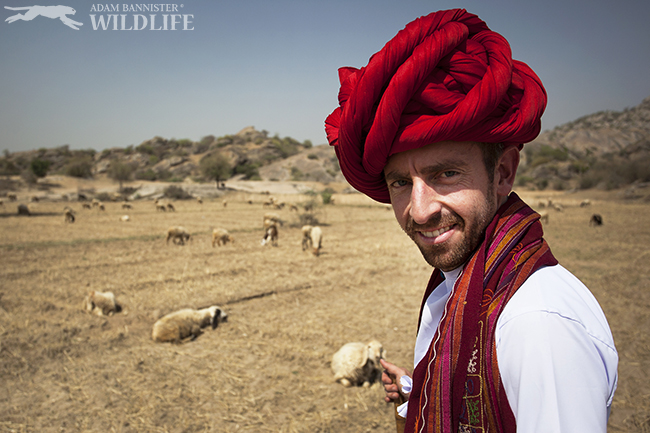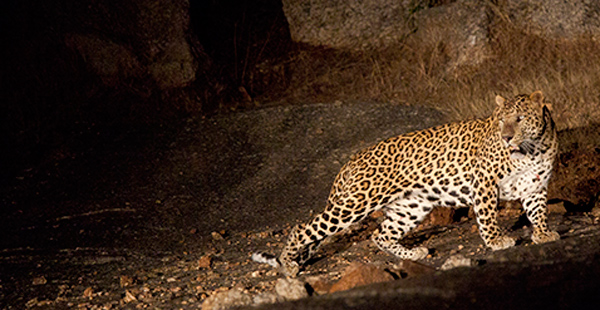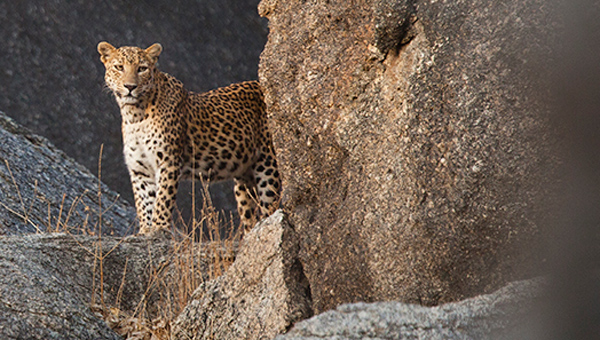Up close with Jawai's unusual leopards - and a leopard-tracker to match

"Tracking leopards or lions," says Adam Bannister, "is easy. The real test lies in setting out to track one particular cat."
It's a cocky statement for a 30-year-old to make - especially when he comes from distant South Africa and the leopards he's currently obsessed with are in the wilds of Jawai, part of Pali district in Rajasthan.
But then neither Jawai nor its most passionate tracker are ordinary.
This is leopard country, and it's spectacular
Protruding from the bleak, barren desert wilderness of south Rajasthan, the jet black granite-dome like rocks of Jawai disrupt the otherwise flat landscape. Cracked, fractured and fissured, born deep within the earth's crust, these ever-changing rocks are home to a growing leopard population.
Leopards are solitary animals, with a full-grown adult requiring large tracts of territory to itself. However in Jawai, given the growth of human infrastructure and the lack of any form of vegetation, the only safe zones for the leopards are the granite rock hills, which they are forced to share, a break from their known behaviour.

At home: Adam Bannister
This lack of space has resulted in an unlikely coexistence, a forced wisdom of simply 'getting along'. So much so, that while traveling through the hills at night Adam has stumbled across an unheard of phenomenon, a group of leopards feeding together much like a pride of lions.
My first encounter with man and beast
It was my first encounter with both leopard and Bannister.
His back arched, he stood motionless facing a wall of granite. His head, inches from the rough surface of the dark-grey rock moved slowly, scanning every crevasse, crack and rupture of the rocky slope.
As we slipped and struggled, at times forced onto all fours, navigating our way across the 50-degree incline of the rock-face, he stood nonchalant. Stabilised by his outstretched limbs, his six-foot-two wiry frame clung to the rocks. He paused briefly, allowing us to mount our camera on the tripod and hit record, and then he was off, running straight up the steep incline in search of a better vantage point to spot the female leopard and her cubs.

Making our way back to the jeep, each step a hostile rebellion for balance, it dawned on me that 'Big-Cat' expert Adam Bannister unmistakably resembled the cats he had spent years studying.
Over the next three days, I found observing Adam substantially more interesting them filming the leopards. The animals are magnificent, but unless you are really up-close, after the initial excitement of spotting the cat, it can be faintly underwhelming: they just sit there looking at you, occasionally licking themselves.
On the other hand, convinced he looks like a mix of Bradley Cooper and as he put it, 'the guy from Coldplay'(Chris Martin), Adam was irrepressible. Bouncing in the back of the open Gypsy, I had a front row ticket to the sometimes bizarre, sometimes hilarious Adam Bannister show.
Born to be wild
You'd think a big-game wildlife expert would be still, quiet, with deep reserves of patience. Adam Bannister, however, has as much personality and flash as the animals he tracks.
His journey with big cats finds root in a temper tantrum on the sets of South African reality show Bush School. Unable to remain on the sidelines while his brother had all the fun, the then five-year-old Bannister pushed another participant off a ladder, destroying the episodes' continuity as the boy cut his nose. Fed up of the repeated disruption, the director saw no way out but to cast Adam and the rest, as they say, is history.
As Adam describes it, the cast spent their mornings by a dried-up riverbed, perched in the shade on a dead Jackalberry tree. Under the constant gaze of multiple cameras, topics such as camouflage, predation, eyesight and seasons were discussed and debated.
"It was here that I first became aware of the issues conservation faces in an increasingly-populated, consumerist and corporate driven society. I may not have been any good at more conventional subjects like math but the greatest teacher on earth, Nature, taught me many of the skills I use in my day-to-day life, whether tracking big cats, catching snakes or negotiating rough terrain in a 4x4."
From the age of 5, the wild became a part of Adam's life. He lost himself in bird books, looking forward to weekend camping trips to Kruger National Park.
Leopards are solitary animals, with a full-grown adult requiring vast tracts of land to itself
As a lanky teenager in Johannesburg, he donned the outfit of an explorer for the Red Hill High School's annual play. He loved to play the part of the adventurer, to imagine he was David Attenborough out in the jungle tracking an elusive wild cat and after completing his B.Sc. in Conservation Ecology from Stellenbosch University he found himself in the hot, humid, minefield of leaches found in the Pantanal wetlands of Brazil.
Engulfed by a never-ending cloud of mosquitos, cut off from the world, Adam's job in Brazil was 'simple': walk into the jungle, track down and then habituate wild jaguars.
Except this was no Kruger National Park, he was in unfamiliar territory tracking a cat he didn't know and the jaguar, unsurprisingly, doesn't respect the whims of men.
Adam's game-changing encounter with the cat came on a Sunday. It being a day off, the team was sleeping in - except, unable to fight his body clock, Adam woke with the sunrise and decided to take a walk.
Roughly 200m from his cabin, and still slightly groggy, he found a dead bull covered in fresh blood and blood-soaked jaguar tracks heading into the jungle.
Fairly certain he would not find the cat, and unwilling to wake the quiet camp for a wild goose chase, he decided to follow the prints alone. Grass gave way to thick brush that soon turned into waist-high grass, but the tracks were visible, so he persisted until he reached a small pool, where he paused to think 'the Jaguar could be close'.
Why do leopards behave as they do? Adam Bannister delved deep into their behaviour and terrain to understand
Before the then 27-year-old could complete his thought, the jaguar charged towards him, stopping barely a few feet short. Still covered in the bull's blood, the jaguar looked straight at Adam: snarling, hissing and slapping the ground in front of him. All he could see was a blur of teeth, blood and claws as he stood frozen to the ground, not knowing how to react, waiting for the cat to pounce and finish him off.
But the cat never attacked. Adam kept his head down and without making eye contact, slowly walked back.
It could have scared him out of the bush forever. Instead, as he ran back, crippling fear gave way to an adrenaline rush and exhilarated, he woke up the entire camp, as the story had to be told.
A perfect communion of man and beast
Since then, he has delved deep into the behaviour of big cats to understand why they do what they do. Every insight is hard-won, with countless tales and close encounters shaping his understanding - and his irrepressible enthusiasm.
To understand animal behaviour, he has found, you must develop a deep understanding of local circumstances: terrain, resources, how the community engages with the animals.

Which is why, when he was hired by Jawai Leopard Camp to help build a sustainable wildlife camp structure, he first set out to become as familiar with the terrain as the big cats were.
Armed with a camera, he trekked the hills relentlessly, often with just a rock for safety, to map them, track each individual leopard, study their behaviour patterns as well as train locals on how to guide visitors safely through these parts.
Having spent close to two years in Rajasthan, the local culture has rubbed off on him. It manifests through his vocal chords - as we flew past small houses waving out to children, they scurried into the road to see the now-familiar sight of a white man wearing shades and a baseball cap singing in a thick South African accent, 'wanna be my chammak challo, o, o, oh,' (on repeat for three days).
The prankster disappeared the minute we entered hallowed territory, though: the Jawai hills. He grew quiet, bright blue eyes following a path invisible to untrained eyes; it was like watching an artist at work.
Cut from the same cloth as the 'great-white hunters' of years gone by, Bannister knew each cave, each cleft in the rocky hills and over time and through repeated treks into their habitat, developed an intimate understanding of the leopards. Before my visit to Jawai I had seen one leopard in my life. In three days, with Adam guiding us, we saw 11.
The tracker who defies the norm
You are taught to be neutral to your surroundings in the wild. Neutrality, though, is not in Adam's DNA - he often develops close bonds, an attraction, with one particular animal, usually the underdog. This bond adds to the excitement of tracking and becomes a real test. In Jawai, however, Adam's 'favourite' animal wasn't an underdog but the alpha-leopard, Nagvasi.
A massive specimen, Nagvasi was the first leopard Adam studied in the region and through him, he was able to understand the unusual and fascinating behavior of leopards in Jawai.
Here, leopards live at peace with the local human population. The lack of natural prey has forced the 29-strong leopard population to be almost wholly dependent on local livestock, feeding largely on the herds of the Rabari's, traditional herdsmen, as well as village dogs.
In Jawai, leopards live at peace with the local human population. As far back as oral history goes, they've never killed a man here
Rather than killing the leopards, the locals accept these attacks as a blessing from the Devi, a boon that will ensure that their herds remain strong and free from sickness. In return, the cats leave humans alone; in the last 150 odd years, as far back as local oral history goes - and unlike other parts of the country - leopards have never killed a human being in Jawai.
Adam puts this lack of 'man eating' to his 'accelerate life' theory. Of the 29 cats he has tracked and photographed in the area, not one is over the age of 10 and one of the widely accepted reasons for cats turning to human prey is the general wear-and-tear of age and fighting.
However in Jawai, cats do not live long enough to explore the idea of eating humans. The reason for this, he argues, is the highly competitive environment created by the limited number of hills and while on some hills leopards have learnt to coexist, on others, they will fight, even kill to protect the area. To survive in Jawai, leopards need to be fighting fit - which is why you never encounter an old, malnourished or injured cat. It is, in the most primal way possible, the survival of the fittest.
For the tracker, though, survival means putting his personal life on hold. The thrill, the adrenaline, the stories, the encounters with species most of us never see outside our TV screens, comes at a price.
Stuck in far-flung places, cut off from home, from any semblance of the familiar - and usually with a bunch of men - the one thing he misses is having someone to share the magic with. "Oh damn, that's the hardest," he says on a crackling Skype line. "There have been so many instances where I wake to some incredible sight and wish there was someone next to me share that with. That's the end goal, isn't it?"
See more of Adam's work at www.adambannisterwildlife.com or on Facebook as Adam Bannister Wildlife






![BJP's Kapil Mishra recreates Shankar Mahadevan’s ‘Breathless’ song to highlight Delhi pollution [WATCH] BJP's Kapil Mishra recreates Shankar Mahadevan’s ‘Breathless’ song to highlight Delhi pollution [WATCH]](https://images.catchnews.com/upload/2022/11/03/kapil-mishra_240884_300x172.png)

![Anupam Kher shares pictures of his toned body on 67th birthday [MUST SEE] Anupam Kher shares pictures of his toned body on 67th birthday [MUST SEE]](https://images.catchnews.com/upload/2022/03/07/Anupam_kher_231145_300x172.jpg)






